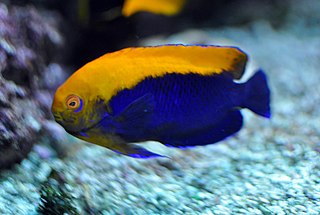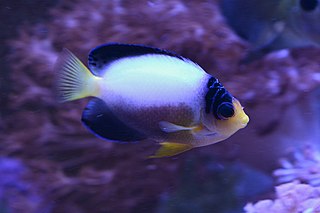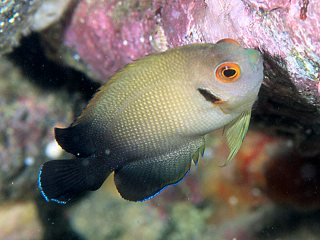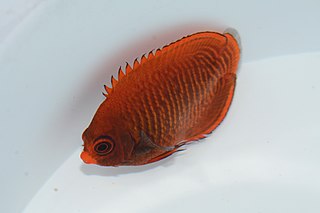
The cherubfish, also known as the pygmy angelfish, is a species of marine ray-finned fish, a marine angelfish belonging to the family Pomacanthidae. It is found in the western Atlantic Ocean.

The lemonpeel angelfish, also known as the yellow angelfish, is a species of marine ray-finned fish, a marine angelfish belonging to the family Pomacanthidae. It is found in the Indo-Pacific region.

The twospined angelfish, also known as the dusky angelfish, or coral beauty, is a species of marine ray-finned fish, a marine angelfish belonging to the family Pomacanthidae. They are found in the Indo-Pacific.

The flameback angelfish, also known as the flameback pygmy angelfish, Brazilian flameback angelfish, Caribbean flameback angelfish or fireball angelfish, is a species of marine ray-finned fish, a marine angelfish belonging to the family Pomacanthidae. It is found in the western Atlantic Ocean.
The resplendent pygmy angelfish is a species of marine ray-finned fish, a marine angelfish, belonging to the family Pomacanthidae. It is endemic to Ascension Island in the South Atlantic Ocean.

Centropyge eibli, the blacktail angelfish, red stripe angelfish, orangelined angelfish, or Eibl dwarf angel is a species of marine ray-finned fish, a marine angelfish belonging to the family Pomacanthidae. It is found near reefs in the Indo-Pacific.

Centropyge heraldi, the yellow angelfish or Herald's angelfish is a species of marine ray-finned fish, a marine angelfish belonging to the family Pomacanthidae. It comes from the Pacific Ocean and sometimes makes its way into the aquarium trade.

Centropyge tibicen, the keyhole angelfish, black angelfish, whitespot angelfish or puller angelfish, is a species of marine ray-finned fish, a marine angelfish belonging to the family Pomacanthidae. It is found in the Indo-Pacific region.

Centropyge multicolor, the multicolor angelfish or pearlback angelfish, is a species of marine ray-finned fish, a marine angelfish belonging to the family Pomacanthidae. It is from the Pacific Ocean that sometimes makes its way into the aquarium trade. It grows to a size of 9 cm in length.

Centropyge potteri, commonly known as the russet angelfish, Potter's angelfish or Potter's pygmy angelfish, is a species of marine ray-finned fish, a marine angelfish belonging to the family Pomacanthidae. It is found in the central Pacific Ocean.

Centropyge ferrugata, the rusty angelfish, is a species of marine ray-finned fish, a marine angelfish belonging to the family Pomacanthidae. The rusty angelfish comes from the Western Pacific Ocean and sometimes makes its way into the aquarium trade.

Centropyge multispinis, known by the common names bluefin dwarf, brown pygmy angelfish, dusky angelfish, dusky cherub, many-spined angelfish, and multispined angelfish, is a species of marine ray finned fish, a marine angelfish belonging to the family Pomacanthidae. It is found in tropical waters of the Indo-Pacific area.

Centropyge fisheri, the orange angelfish, whitetail angelfish, damsel angelfish, yellowtail angelfish, Hawaiian flame angelfish, Fisher’s angelfish, Fisher’s dwarf angelfish or Fisher’s pygmy angelfish, is a species of marine ray-finned fish, a marine angelfish belonging to the family Pomacanthidae. It is found in the Indo-Pacific region.

Centropyge vrolikii, known commonly as the pearlscale angelfish or half black angelfish, is a species of marine ray-finned fish, a marine angelfish belonging to the family Pomacanthidae. It is found in the Indo-Pacific.
The blue velvet angelfish, also known as the Fiji blue midnight angelfish, is a small species of marine ray finned fish, a marine angelfish belonging to the family Pomacanthidae. It is only known from Fiji where it was initially considered to be a variety or subspecies of the midnight pygmy angelfish.

Golden angelfish, also known as golden pygmy angelfish or velvet dwarf angel, is a small marine ray-finned fish, a marine angelfish belonging to the family Pomacanthidae. It inhabits shallow reefs in the western Pacific Ocean.

The peppermint angelfish is a relatively small species of marine ray-finned fish, a marine angelfish belonging to the family Pomacanthidae. It is found in the Central area of the South Pacific Ocean, and is known to be native to the Cook Islands.
Centropyge nox, known commonly as the midnight angelfish or dusky angelfish, is a species of marine ray-finned fish, a marine angelfish belonging to the family Pomacanthidae. It is found in the Western Pacific Ocean.

Centropyge shepardi, the mango angelfish, Shepard’s angelfish or Shepard’s pygmy angelfish, is a species of marine ray-finned fish, a marine angelfish belonging to the family Pomacanthidae. It is found in the Western Pacific Ocean.

Centropyge flavipectoralis, known commonly as the yellowfin angelfish or moonbeam angelfish, is a marine ray-finned fish, a marine angelfish belonging to the family Pomacanthidae. It is native to the Indian Ocean.



















